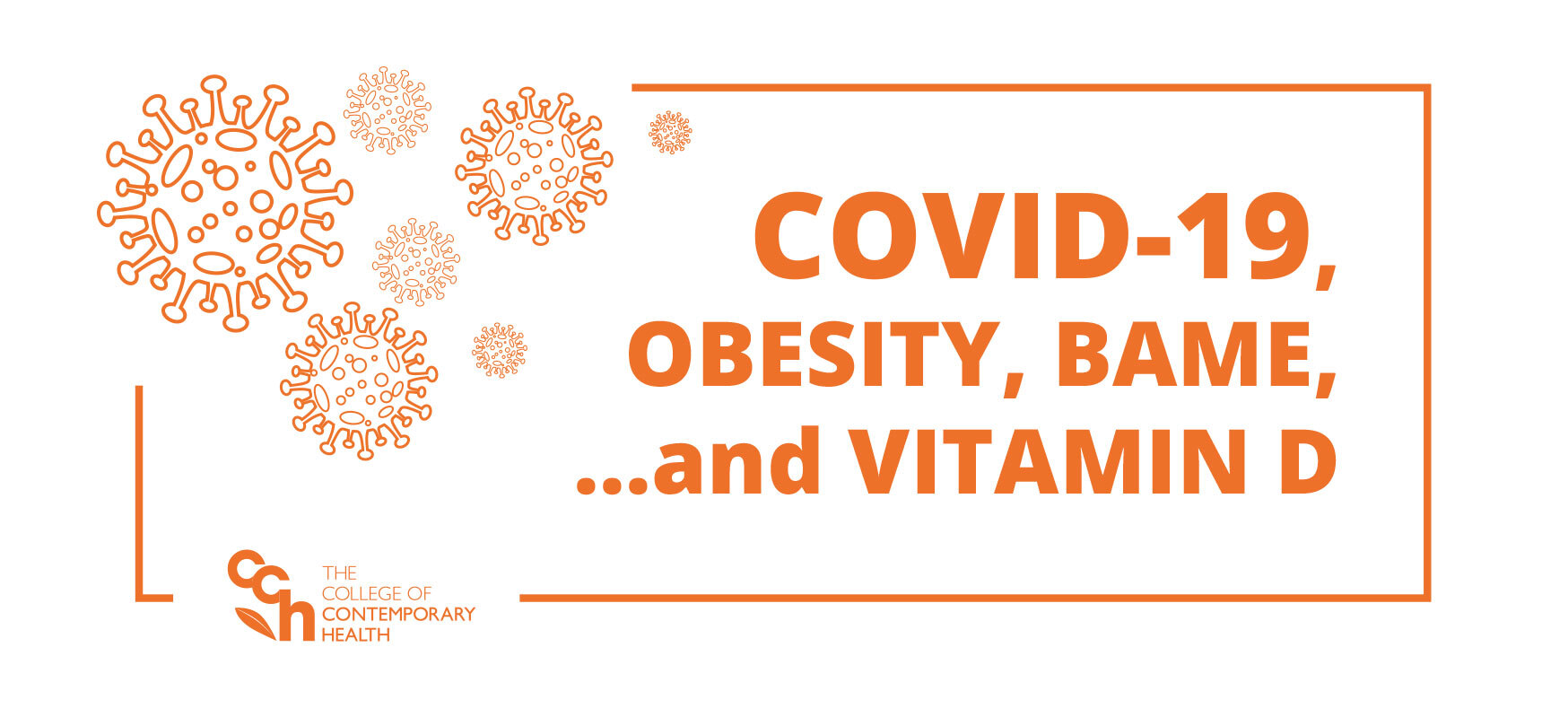
Covid-19, Obesity, BAME… and Vitamin D
Covid-19 and ethnicity
Over recent weeks, as the coronavirus pandemic has progressed, we have been inundated with data and statistics about the impact of the virus in a range of different countries, communities and demographic groups, but perhaps the most shocking are the numbers of people from black, Asian and minority ethnic (BAME) backgrounds who have died from Covid-19.
The numbers
In the UK, concern was first aired when it was reported that the first ten doctors to die from the virus were all from BAME groups (1), and that more than 60% of all healthcare workers to die from the coronavirus were BAME individuals (2). Early data on the ethnic breakdown of Covid-19 patients entering hospital revealed that 34% were of BAME heritage, compared to 14% of the population as a whole (3). A recent report from the Institute of Fiscal Studies (IFS) revealed that people of British Black African heritage are 3.5 times more likely to die from Covid-19 compared with the white population; people of Black Caribbean heritage 1.7 times more likely and British Pakistanis 2.7 times more likely (2).
On the other side of the Atlantic, a similar picture has emerged with regard to African-Americans, who have accounted for 27% of Covid-19 deaths (a mortality rate 2.6 times that of white Americans) according to a recent report (4). These disparities in death rates between ethnic groups are likely to be due to a complex interplay of a multitude of factors which influence health behaviours, immune profiles, infection risk and health outcomes (5).
Social, economic and health issues
In the US, attention has focused on the fact that African Americans are often socioeconomically disadvantaged, live in more densely populated areas and more crowded conditions. This potentially increases transmission of the virus. They are also more likely to be employed in key worker roles, and less likely to be able to work from home, so have greater risk of infection (6). In addition, African-Americans have higher incidence of obesity, type 2 diabetes mellitus (T2DM) and hypertension than their white counterparts (7, 8) – these have been identified as the three biggest risk factors for severe Covid-19 illness after age (9).
These socioeconomic and health issues are similar for BAME communities in the UK. They often live in densely populated areas and sometimes live in extended, multi-generational cohabiting families, which could increase infection of vulnerable members of the community. People from BAME backgrounds also represent a disproportionate number of medical and support staff in the NHS, so may be more exposed to the SARS-CoV-2 virus (2). The Black African / Caribbean population has the highest rate of obesity of all ethnic groups in the UK (10), but the most significant health issue affecting BAME groups is T2DM, which is of course a significant risk factor for Covid-19 morbidity and mortality. Black and South Asian populations in the UK have 3-5 times the prevalence of T2DM compared to the white population, and are diagnosed on average 10-12 years younger (11). Clearly there are a number of social, economic and health factors which may be contributing to increased risk of infection and increased severity of Covid-19 in BAME populations, but there is one
further factor that should be considered – the possible role of vitamin D deficiency in vulnerability to Covid-19.
Vitamin D
Vitamin D is essential for regulation of immune function, and has been shown to reduce the production of pro-inflammatory cytokines that are associated with lung damage caused by acute viral respiratory infections such as influenza and Covid-19 (12). In fact, supplementation with vitamin D reduces the risk of respiratory infection, particularly in people with low vitamin D status (13). Vitamin D is synthesised under the skin following exposure to UVB radiation from sunlight, so individuals who get insufficient sunlight are at risk of vitamin D deficiency. This is a particular issue during winter in countries further from the equator, when sunlight has insufficient UVB for vitamin D synthesis. People with darker skin colour who live in these countries, which includes many BAME communities, are at even greater risk, as are those who rarely go outside or expose very little skin to the sun (14).
It is therefore very interesting to note that the current coronavirus pandemic took hold at the end of winter in the northern hemisphere (the time of year when vitamin D status is at its lowest) and the countries most affected by the virus are in the northern hemisphere, above 35 degrees latitude (15). At the same time, countries at the end of summer in the southern hemisphere, such as Australia and New Zealand, have fared very well. Furthermore, a cross-sectional analysis of countries in Europe has shown a statistically significant correlation between population vitamin D levels and Covid-19 cases and deaths (16).
Vitamin D deficiency could therefore be contributing to the disproportionate number of BAME individuals who are succumbing to Covid-19. It is also interesting to note that vitamin D status tends to fall with age, particularly for older people in care homes, and with rising BMI (17). Obesity is strongly associated with vitamin D deficiency, although why this is the case is not clear. The leading theory is that dysfunctional adipose tissue in obesity sequesters vitamin D and impairs its release so it is no longer bio-available (18). Vitamin D plays an essential role in glucose homeostasis, insulin sensitivity and regulation of adipokines such as leptin, as well as inflammatory cytokines (19). Vitamin D insufficiency may therefore be involved in mediating insulin resistance and inflammation associated with obesity.
Vitamin D deficiency could therefore be a part of the Covid-19 pandemic jigsaw, contributing to the vulnerability of people with obesity as well as those of BAME heritage. Routine vitamin D screening could be introduced for hospitalised Covid-19 patients, and BAME health and social care workers, especially those with excess weight, to establish whether there is a link and to provide the opportunity to correct any deficiencies as part of treatment and prevention measures.
Conclusion
Vitamin D is just one of many factors, as discussed here, which might contribute to the vulnerability of BAME individuals to Covid-19, but it could be contributing to a toxic combination of factors, including obesity and other comorbidities, that is putting our BAME communities, particularly those individuals working on the frontline of health and social care, at very high risk of severe Covid-19 illness. Unfortunately, the risk to BAME health workers could have been predicted, and measures to protect them put in place, as the mortality rate for the BAME population for the 2009 influenza A (H1N1) epidemic in England was nearly twice that of the white population (20). It is vital that research is undertaken to determine the underlying causes of the unacceptably high price BAME communities are paying in the current pandemic. In the meantime, health and social care workers of BAME heritage, especially those with excess weight, should be afforded the protection they merit as key workers at higher risk from Covid-19, including ensuring healthy vitamin D status.
References
- Siddique H (2020) UK government urged to investigate coronavirus deaths of BAME doctors. The Guardian. Published 10 April 2020. https://www.theguardian.com/society/2020/apr/10/uk-coronavirus-deaths-bame-doctors-bma
- Boyd C (2020) Death rate among black and Asian Brits is more than 2.5 TIMES higher than that of the white population, reveals stark analysis by Institute of Fiscal Studies. Mail Online. Published 1 May 2020. https://www.dailymail.co.uk/news/article-8276097/Clear-disparity-ethnic-groups-Covid-19-deaths-IFS-study.html
- Intensive Care National Audit Research Centre (2020) ICNARC report on COVID-19 in critical care. Published 17 April 2020. https://www.icnarc.org/Our-Audit/Audits/Cmp/Reports
- APM Research Lab (2020) The colour of coronavirus: Covid-19 deaths by race and ethnicity in the US. Published 1 May 2020. https://www.apmresearchlab.org/covid/deaths-by-race
- Pareek M, Bangash MN, Pareek N, Pan D, Sze S, Minhas JS, Hanif W, Khunti K (2020) Ethnicity and Covid-19: an urgent public health research priority. The Lancet. 395(10234): 1421-1422.
- Gupta S (2020) Why African-Americans may be especially vulnerable to COVID-19. Science News. Published 10 April 2020 https://www.sciencenews.org/article/coronavirus-why-african-americans-vulnerable-covid-19-health-race
- Centers for Disease Control and Prevention (2020) National diabetes statistics report 2020. https://www.cdc.gov/diabetes/pdfs/data/statistics/national-diabetes-statistics-report.pdf
- American Heart Association (2016) High blood pressure and African Americans. https://www.heart.org/en/health-topics/high-blood-pressure/why-high-blood-pressure-is-a-silent-killer/high-blood-pressure-and-african-americans
- Richardson S, Hirsch JS, Narasimhan M, Crawford JM, McGinn T, Davidson KW, and the Northwell COVID-19 Research Consortium (2020) Presenting Characteristics, Comorbidities, and Outcomes Among 5700 Patients Hospitalized With COVID-19 in the New York City Area. JAMA. Published online 22 April 2020. doi:10.1001/jama.2020.6775
- UK Government (2019) Ethnicity facts and figures. https://www.ethnicity-facts-figures.service.gov.uk/health/diet-and-exercise/overweight-adults/latest
- Goff LM (2019) Ethnicity and Type 2 diabetes in the UK. Diabetic Medicine. 36: 927-938 12
- Greiller CL and Martineau AR (2015) Modulation of the Immune Response to Respiratory Viruses by Vitamin D. Nutrients. 7: 4240-4270
- Martineau AR, Jolliffe DA, Hooper RL, et al. (2017) Vitamin D supplementation to prevent acute respiratory tract infections: systematic review and meta-analysis of individual participant data. BMJ. 356: i6583. doi:10.1136/bmj.i6583
- National Institute of Health and Care Excellence (2018) Vitamin D deficiency in adults – treatment and prevention. https://cks.nice.org.uk/vitamin-d-deficiency-in-adults-treatment-and-prevention#!backgroundSub:2
- Rhodes JM, Subramanian S, Laird E, Kenny RA (2020) Editorial: low population mortality from COVID-19 in countries south of latitude 35 degrees North supports vitamin D as a factor determining severity. Aliment Pharmacol Ther. 00: 1–4. DOI: 10.1111/apt.15777
- Ilie PC, Stefanescu S, Smith L et al. (2020) The role of Vitamin D in the prevention of Coronavirus Disease 2019 infection and mortality. PREPRINT (Version 1) available at Research Square https://doi.org/10.21203/rs.3.rs-21211/v1
- Vimaleswaran KS, Berry DJ, Lu C, et al. (2013) Causal relationship between obesity and vitamin D status: bi-directional Mendelian randomization analysis of multiple cohorts. PLoS Med. 10: e1001383. doi:10.1371/journal.pmed.1001383
- Pramono A, Jocken J, Blaak E (2019) Vitamin D deficiency in the etiology of obesity related insulin resistance. Diabetes Metab Res Rev. 35: e3146 https://doi.org/10.1002/dmrr.3146
- Zakharova I, Klimov L, Kuryaninova V, Nikitina I, Malyavskaya S, Dolbnya S, Kasyanova A, Atanesyan R, Stoyan M, Todieva A, Kostrova G and Lebedev A (2019) Vitamin D Insufficiency in Overweight and Obese Children and Adolescents. Front. Endocrinol. 10: 103. doi: 10.3389/fendo.2019.00103
- Zhao H Harris RJ Ellis J Pebody RG (2015) Ethnicity, deprivation and mortality due to 2009 pandemic influenza A(H1N1) in England during the 2009/2010 pandemic and the first post-pandemic season. Epidemiol Infect. 143: 3375-3383.




